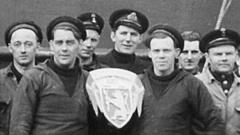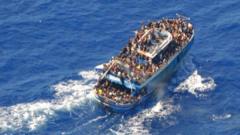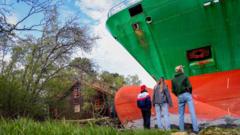The Shetland Bus was a clandestine mission that utilized fishing boats to transport agents and refugees between Scotland and Nazi-occupied Norway. This year marks the 80th anniversary of VE Day, prompting a reenactment of the perilous journeys made by these courageous vessels.**
The Shetland Bus: Unsung Heroes of Norway's Resistance Against Nazi Occupation**

The Shetland Bus: Unsung Heroes of Norway's Resistance Against Nazi Occupation**
Recounting the daring operation that facilitated Norway's resistance during WWII, highlighting the 80th anniversary of VE Day.**
The Shetland Bus, a pivotal yet often overlooked operation during World War II, played a significant role in aiding the Norwegian resistance against Nazi Germany. Conceived in the dead of winter and executed under the cloak of night, small fishing boats departed from Scotland's Shetland Islands, journeying 200 miles to deliver crucial supplies and specially trained agents to remote Norwegian coastal areas, while clandestinely bringing back refugees eager to escape the grips of occupation.
In a tribute to the 80th anniversary of Victory in Europe (VE) Day, six historic vessels that participated in the Shetland Bus missions are set to recreate these daring crossings from Bergen, Norway, back to Shetland. Scheduled to arrive in Lerwick in time for VE Day commemorations, this event serves as a reminder of the brave souls who took part in these life-risking operations.
The story of the Shetland Bus began with the German invasion of Norway on April 8, 1940, leading to the Norwegian government, including King Haakon VII, fleeing to London. Many Norwegians sought sanctuary in the UK aboard small fishing vessels, crossing the treacherous North Sea. In July of the same year, British Prime Minister Winston Churchill established the Special Operations Executive (SOE) to conduct sabotage and intelligence missions across occupied Europe. This secret organisation included the Shetland Bus initiative, which became vital in supporting the Norwegian resistance movement.
From 1940 to 1945, the Shetland Bus missions encompassed approximately 200 crossings of the North Sea, transporting numerous resistance fighters, essential weapons, and supplies, while also rescuing over 300 Norwegian refugees. These daring trips predominantly occurred in the winter months, leveraging the cover of darkness to evade detection by German patrols. The treacherous sea conditions often posed significant challenges, with many crews battling severe weather and the constant threat of enemy discovery.
For instance, on September 27, 1941, the MK Arnefjord successfully transported 20 refugees despite an intense storm, while others in its convoy faced less fortune—four of the six boats managed to complete the perilous journey, but ten fishing boats were ultimately lost during the operations, claiming the lives of 44 men.
Morten Neset, the current captain of the MK Arnefjord, will lead the reenactment journey to Shetland during the VE Day commemorations. Neset reflected on the importance of executing these missions during the winter months, emphasizing that such timing was critical to avoid German detection: “The Shetland Bus was really essential for the general population of Norway as it illustrated that someone was 'standing up for them,' contributing to their resistance against the occupation."
The Shetland Bus connection continues to resonate today, with the local community in Shetland maintaining a warm relationship with Norwegians who fled their home country. According to Bill Moore from the Shetland Bus Friendship Society, it is difficult to measure the direct impact of these operations on the war; however, they undoubtedly provided optimism and a sense of hope to Norwegians under siege.
As the six vessels set sail from Bergen on May 6 and are programmed to arrive in Lerwick in the morning, the act of remembrance also highlights the enduring ties forged during a time of hardship, linking the residents of Shetland and their Norwegian counterparts in a shared legacy of resilience and courage.


















